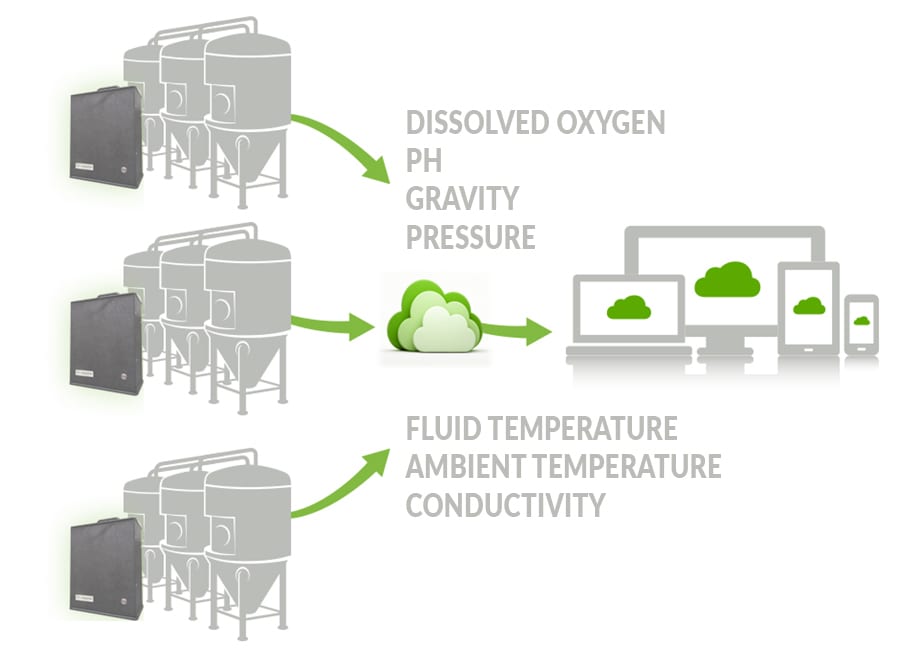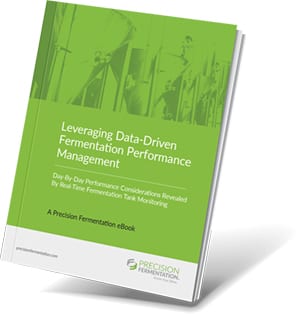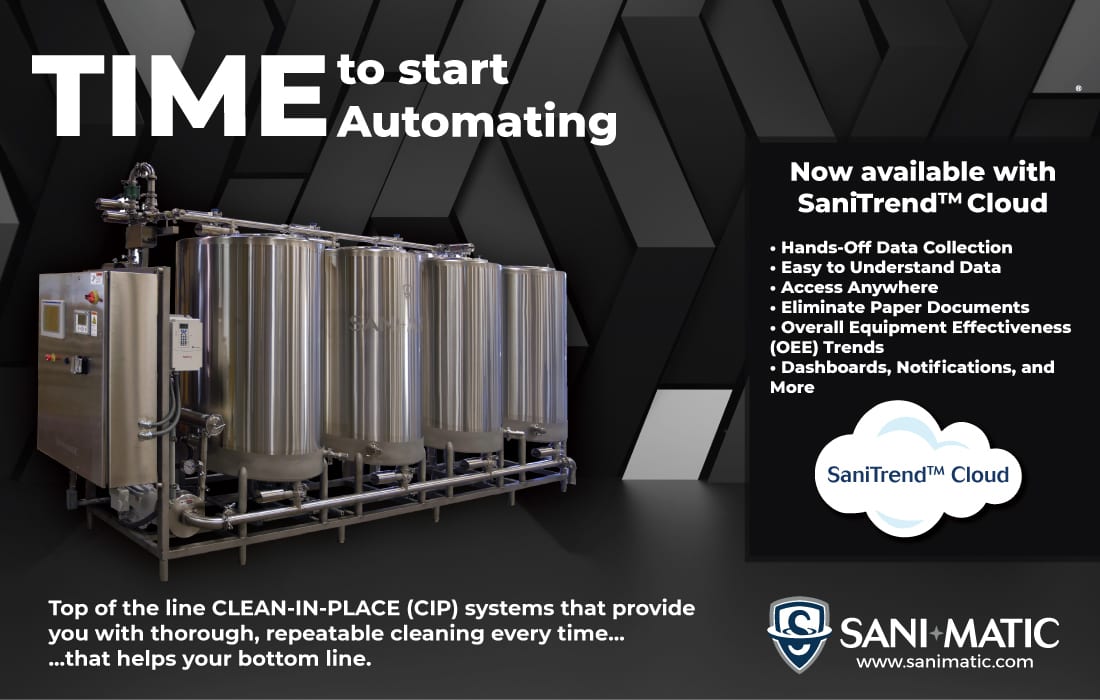Getting consistent results
from fermentation
If you don’t measure it, you can’t control it, so having the right data means a great, consistent batch every time
Baking bread, making yogurt and brewing beer have one thing in common: fermentation. While it’s relatively easy to control a chemical process, controlling a process with a living, biological organism involving fermentation can be trickier—so you need all the help you can get.
If you make a successful batch of beer, can you repeat it? One way to improve the probability of making subsequent successful batches of the same brew is to have recorded the process variables or parameters of the batch from the very beginning to the end of the process. You can use manual techniques, but with today’s sensors and software, the tools are available to make the monitoring task automatic—no forgetting to write down a temperature or pressure value, no need to be on site.
Precision Fermentation (founded in 2017 by people who have intimate knowledge of brewing beer, cell-cycle biology and bio-computational science) has come up with a way to provide continuous monitoring and recording of critical brewing parameters—dissolved oxygen (DO), pH, gravity, temperature, pressure and conductivity)—so you can know what parameters created the successful batch. This means you can make process changes if the batch is headed in the wrong direction, save the brew and save some money—and create less environmental waste.
I spoke with Dave Frizzell, senior product development specialist, and Andy Morrison, sales engineer, at Precision Fermentation to get some details on creating consistent brews by having actionable data to make critical decisions on maintaining a batch as it brews. Both have had extensive hands-on experience in brewing beers, so it wasn’t a leap for them to create a set of tools to make the brewing experience easier.
Wayne Labs, Senior Technical Editor
Intro video courtesy of Getty Images/Konstantin Mikhidov
Andy Morrison
Morrison helps to connect and inform all of the internal teams that support the BrewMonitor System, and educates customers on the use of the system and best practices. He previously served as a craft beer sales & marketing director at Harris Beverages, a family-run beer wholesaler in Durham, N.C. While coordinating the local efforts of his craft portfolio, he became one of the first 75 people globally to earn the Advanced Cicerone® certification. As an Advanced Cicerone, Morrison possesses extensive style knowledge, hands-on experience managing beer service, a deep understanding of the brewing process and ingredients, and expertise in beer and food pairing. He received his BS in Physics from the University of Puget Sound.

Dave Frizzell
Frizzell leads all on-tank product testing programs for the BrewMonitor® System. Previously, he managed QA efforts for a series of breweries, first in the Boston area and then in Raleigh-Durham, including Jack’s Abby Craft Lagers, Trophy Brewing and Starpoint Brewing. Frizzell is widely experienced in the intricacies of the fermentation processes, across many varieties of yeast and bacteria, based on years of hands-on production management for world-class beers. He received his B.S. in Biology from the University of Massachusetts with a focus on microbiology and human pathology.

FE: I watched a lecture from your website entitled, “Yeast Vitality and Fermentation Reproducibility,” where Dr. Steven Haase, Duke University Departments of Biology and Medicine and Scientific Advisory Board to Precision Fermentation, described the issues with predicting desktop yeast culture vitality (as opposed to industrial beer brewing in large vessels), and he said it was hard enough to compare yeast fermentations in a 200 mL flask vs. a 2,000 mL flask, let alone translating to multi-gallon industrial brew vessels.
One thing I came away with was that having real-time data was critical in keeping yeast vital and performing at its best, batch after batch. So in brewing a single batch of beer, is it best practice to observe parameters (DO, pH, gravity, pressure, temperature, conductivity) of a successful batch and use those for comparison of successive batches of the same beer style? How often should these parameters be checked? What generally has been the practice of monitoring ongoing batches in the industry?
Dave Frizzell and Andy Morrison: Generally, brewers have a solid understanding of how the fermentation process should proceed, and they take one or two samples per day by hand to ensure the beer is on track. Those samples will include temperature, gravity and pH. However, the first 24 hours after pitching yeast are the most interesting when it comes to determining the health of your yeast crop. We’re aiming to allow brewers to take advantage of real-time monitoring to track the early stages of fermentation closely without having dedicated manpower to take samples every 30 minutes. Changes in dissolved oxygen and pH can be useful indicators of a healthy yeast pitch, which of course affects the overall batch.
Once a brewer has tracked the fermentation of a successful batch of beer using this technology, we encourage them to use that batch as a benchmark for any subsequent batch of that beer. This has two advantages: First, it allows hands-off data gathering—no need to take manual samples and then manually entering data into one or more databases. Second, it provides simple, actionable analytics. Just looking at the curve of the graph as compared to previous batches can give a brewer the information needed to make critical business decisions.

The BrewMonitor System: The BrewMonitor Sensor Hub and BrewMonitor Console web application. Images courtesy of Precision Fermentation
FE: You’ve developed a hardware/software system for fermentation tank monitoring. Could you describe how it works—both from a hardware and software standpoint? Besides monitoring, does it provide any controls to the brewing process? If not presently, could it? Does the system currently make use of any artificial intelligence?
Frizzell: Our hardware consists of the BrewMonitor® Sensor Hub, which houses all of the necessary equipment to take the measurements, and a tank connector to attach the Sensor Hub to your fermentation vessel. This Sensor Hub pumps fluid, be it wort, cider, mead, even kombucha, over a series of sensors and transmits those readings to the cloud. Our web application, BrewMonitor Console, gathers and presents the data in both graphical and table formats for further analysis through any web-connected device. We find the graphs to be the most interesting and useful because it gives the brewer a quick visual representation of how that fermentation is progressing compared to a benchmark fermentation, or even to two other fermentations of their choice. The user interface and analytical capabilities, as well as being able to quickly reference previous batches, is where the product really shines.
Morrison: Artificial Intelligence is a fascinating concept for us. We have some proprietary code that uses previous data to predict and help model the data as it is gathered. It takes into account the information from other batches a brewer produces, but I would call it machine learning rather than AI. We see great potential for integration with controls in the future, making each fermenter part of the Internet of Things. That is not our focus at the moment, but we have discussed how it would be possible!
FE: In the process controls world, certainly the six parameters in Question 1 could have been monitored with equipment and sensors some 30 or 40 years ago—although probably not all of them would have been monitored. How has our understanding of the beer brewing process changed over the years, and how has technology aided in better processes today?
Frizzell and Morrison: This is an interesting question because it really gets to the heart of what we’re excited to be doing within the industry. Fermentation is an integral part of human society and industry, and it has remained fundamentally the same process for literally thousands of years. This means there are elements of the process that are managed certain ways simply because they’ve worked all this time, but there’s still scientific work to be done to fully discover why. While pH meters existed around 40 years ago, they were large and required calibration every 4 hours. Now we have the technology to put six different sensors in a Sensor Hub no bigger than a shoebox, and they will work for months without the need for recalibration. There’s never been the capability to collect such rich information on such a massive scale. Combining this with the ability to clearly see how a change in a single variable impacts the others in real-time is unprecedented. So, where we’ve previously spent all this time and effort looking through a keyhole to try to figure out what’s been happening inside these big fermentation tanks, technology like this allows us to have a full, panoramic view.
Incorporate the research that scientists like Dr. Steven Haase have given us, and we have much better insight into how yeast behave in a fermentation setting. Understanding the replication process, the metabolic pathways, and the reactions to stress that yeast undergo allows us to know what their limits are. Dr. Haase has been studying all this in lab settings with advanced equipment to arrive at his conclusions. We’re taking that same fundamental scientific process to beer brewers and beyond. Now every brewery can track, study, and better control their high quality yeast strains to produce more consistent flavors generation after generation.
FE: In brewing beers today, in general how are the large corporate brewers keeping batches consistent? Are they doing real-time monitoring and/or control?
Frizzell and Morrison: Typically, they take readings on fermentations-in-progress across a smaller range of metrics, visualize those readings, compare them to benchmarks and react to variances. It’s real-time for them in the sense that they collect this data and work to digest it as quickly as they can. The problem lies in the fact that so much happens between readings, you’re not getting the full picture. What we offer is higher frequency monitoring on a broader range of metrics. We provide the ability to redirect time and labor away from the rote work of data collection and entry. Now brewers and quality control teams have the data and analytics at their fingertips to be able to make decisions more quickly and in a more proactive way, and without spending hours running between tanks and a lab. We’ve taken what they do and expanded it to include more data more quickly, while also shrinking the labor/time/money expense in a way that makes it available to all the small brewers out there too.

BrewMonitor is the first real-time, comprehensive fermentation monitoring system, transmitting DO, pH, gravity, pressure, temperature, and conductivity to any web-connected device 24-7.
FE: Maybe a little off topic—how does a brewer make sure incoming yeast is of consistent quality, for example; tests, COAs? How can monitoring the process help compensate for less active or overactive yeast? What arrangements are made with suppliers to keep yeast consistent in quality and vitality? How should yeast be stored before use? How soon should it be used?
Frizzell and Morrison: It really depends on the yeast and the manufacturer. Active Dry yeast is very stable and can be stored cold for a long time as long as the package is not open. Liquid yeast pitches should be used as soon as possible upon delivery and stored cold if it is not pitched immediately. Yeast suppliers are very rigorous in their testing and certification, so paying attention to their guidelines is a great start. They perform cell counts, contamination testing, and viability testing on all batches, and typically include a use-by date.
It’s also important to note that many brewers avoid purchasing new batches of yeast from suppliers for every batch of beer they make. Instead, they harvest yeast from one batch-in-progress to use in upcoming batches. What brewers find with this reharvest and repitch method is that yeast health degrades over many batches of re-use. This can happen within two to three batches or can be extended out much longer if the yeast is managed well and tracked for healthy consistency over time. Like when purchasing liquid yeast, storing your own yeast between batches takes cold storage and short turnaround times. To avoid storage issues, some brewers will work to time batches so they can simply connect and transfer the yeast directly from tank to tank, taking yeast from a finished or near-finished beer to a freshly brewed batch of wort.
Add on top of all this the fact that scheduling brew days can be a challenge for a lot of breweries because of all the variables (i.e. tank space, ingredient availability, manpower). Setting and adhering to a schedule will give your yeast supplier or internal yeast management capability as much lead time as possible to ensure your yeast is ready when you need it. Once fermentation has started, monitoring can give a brewer an early indication of an unhealthy yeast crop and may warn of a slow fermentation. This kind of advanced warning may prevent repitching of unhealthy yeast and will let a brewer know if a tank won’t be ready when they expect. All of these factors play a huge role in scheduling and cellar management.
FE: What of the six parameters (DO, pH, gravity, pressure, temperature, conductivity) have not been checked as frequently as the others by brewers? What could less-frequently checked parameters offer to keep a batch on target and why?
Frizzell and Morrison: Dissolved oxygen is one of the most critical parameters of a successful fermentation and is the least frequently monitored. Many brewers have in-line DO meters to measure the amount of oxygen going into their fermentation vessels, but measuring the total amount in the tank and how quickly the yeast consume that oxygen is vital for yeast health. A very slow rate up in uptake can give a brewer and early warning sign and potentially save a batch less than a day after yeast pitch!
Overall, though, we’re working to look at the data as more than just one parameter at a time, and more than one data point at a time. Brewers have historically used the samples they collect to get a snapshot of what their beer looks like at a single point in time. We’re showing something more akin to a movie. Having the full view of where the beer has been and where it is to the minute you look at it gives a much better sense of where it’s going. And the higher you can resolve the data, the clearer the whole process becomes.
Additionally, this gives brewers the ability to establish much more robust benchmark capabilities. For example, when you can look at the time series for gravity of a currently fermenting batch of beer against an established benchmark, it becomes easier to make predictions about where it will go next and how long it will take to get there. Having a high-frequency time series makes this predictive capability even more precise, and having pH, DO, and conductivity all progressing in their patterns simultaneously against their own high density time series benchmarks makes this capability incredibly powerful. If the density hasn’t moved within the first 24 hours after pitching yeast into your beer, but pH and DO have, and all these parameters are matching the benchmarks you’ve established for them, you know the beer is where it needs to be. This is a profound capability that just wouldn’t be there if you’re only checking your stats once, or three times a day.
“When we talk with brewers for the first time about what we’ve created with this system, there can be confusion about the fact that we’re not just another tool that simply takes a single reading on demand.”
—Dave Frizzell
FE: In using your fermentation/batch monitoring system, can controlling any of the parameters be automated (e.g., temperature or pressure) based on known data that makes a successful batch? Are any brewers using the data from your system to automate the controls so human intervention is not necessary?
Frizzell and Morrison: This is part of what we’re very excited to see develop! We currently have the ability for brewers to put alerts in place for unexpected temperature swings or pressure spikes. And we’ve recently put integration features in place that will allow customers who are interested in streaming data from our system to other systems. We’re now just starting to have conversations with brewers and some of the process control companies that service them. It doesn’t seem very far away for us to integrate with a temperature control system, for example, that would be able to respond accordingly when our system detects temperature variations against standardized benchmarks. But that’s just the beginning. There are so many options out there, it sometimes feels like it’s more a matter of narrowing our focus rather than having to search for what to do next.
FE: You mention alerts for temperature and pressure. Can alerts be set for other metrics in the BrewMonitor software? What are typical alerts that could save a process?
Frizzell and Morrison: Absolutely, we have two methods of setting alerts with the software. The first is what we call static alerts—you set an absolute minimum and maximum threshold, which will only send an alert if the parameter ever strays above or below the alert range. This is useful for metrics like pressure or temperature, since most beers have a well-defined temperature and pressure range. If these alerts are triggered, they will alert the brewer to potential problems with the cooling system, or if a blowoff valve has been left closed. If a brewer receives an early warning of these issues, they can fix the situation and potentially save thousands of gallons of product.
The second method is a dynamic alert range, which sends an alert if the parameter strays outside the acceptable range at that given point in time. This is useful for metrics like gravity and pH that change over the course of the fermentation. We expect the gravity to drop from a high point to a low point, so an absolute maximum or minimum would be far less useful. Instead, the brewer can lean on a previously established benchmark batch for that particular brand. The alert system will take the curve of the graph and set a standard deviation on either side, creating a moving alert range.
FE: Any other key pointers or takeaways that brewers need to know?
Frizzell: I think what we’re doing is a sort of mindset shift, in a sense. When we talk with brewers for the first time about what we’ve created with this system, there can be confusion about the fact that we’re not just another tool that simply takes a single reading on demand. That’s what brewers are used to, so I think they expect to be able to categorize us as such. They come to us looking for a tool that will give them an automatic snapshot of their fermentation. But the reality is that we’re building a whole new way of visualizing fermentation. The industry is used to looking at pictures of fermentations that are frozen in time, but our system shows video. It’s deeper than a single point of data, it’s multidimensional, and it’s moving as you watch. That’s a whole new paradigm for the industry that we’re really excited to be leading. FE


